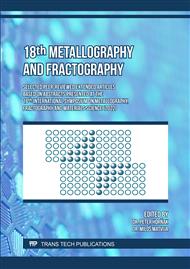p.17
p.23
p.31
p.43
p.59
p.73
p.91
p.97
p.103
Influence of Ligands on Physicochemical Characteristics of Magnetic Nanoparticles
Abstract:
Magnetic-bead separation or purification serves as a technique for effective isolation of biomolecules. In presented work we prepared and characterized core-shell magnetic nanoparticle samples consisted of Fe3O4 core coated with SiO2 shell. Samples were subsequently coated with ligands MPTMS (3-(mercaptopropyl)trimethoxysilane), CPTMS (3-(chloropropyl)trimethoxysilane) and MMSP (3-(trimethoxysilyl)propyl methacrylate) with aim to increase the number of active centers for specific binding with RNA. Such samples were further investigated for their magnetic properties, size, and morphology. Magnetic properties were studied in DC field up to 5 T in temperature range 5 – 300 K. Size and morphology were determined from SEM micrographs and elemental compositions of the samples were investigated using EDX analysis. Modification of nanoparticle surface with different ligands leads to modification of active centers on the SiO2 surface on which the DNA and RNA molecules can be bounded. It also causes the change in magnetic and structural properties of nanoparticles.
Info:
Periodical:
Pages:
91-96
Citation:
Online since:
April 2023
Price:
Сopyright:
© 2023 Trans Tech Publications Ltd. All Rights Reserved
Share:
Citation:



